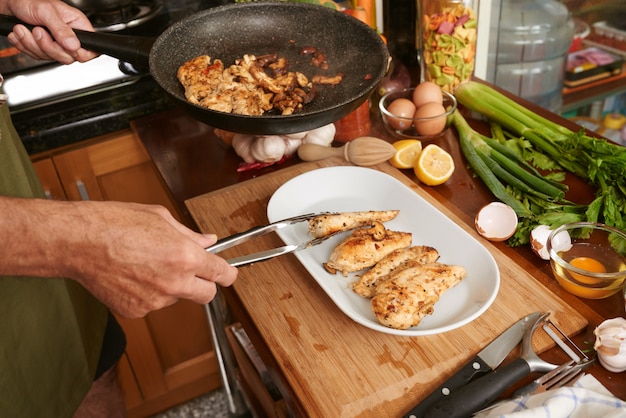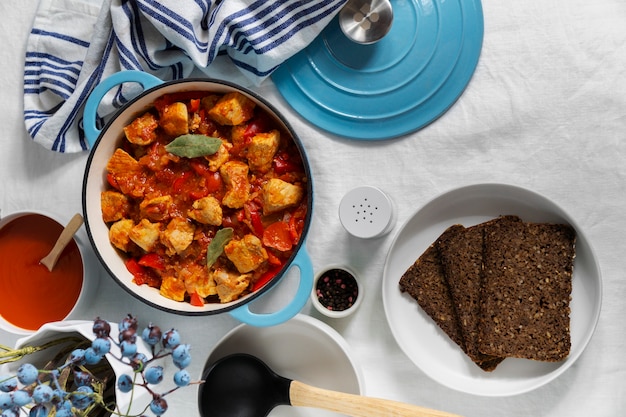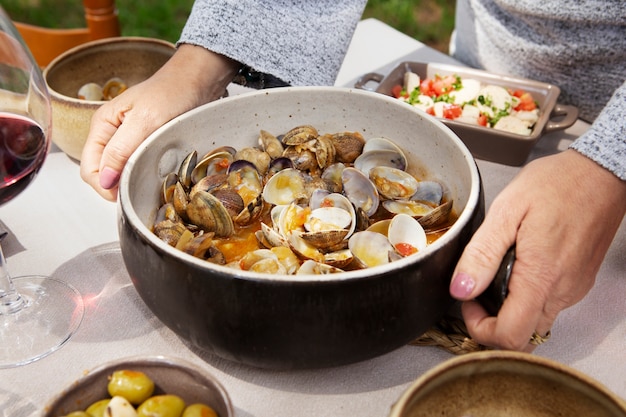Oh, pot roast. You're the ultimate comfort food, a culinary hug in a bowl. A symphony of slow-cooked, fall-apart tenderness and rich, deeply satisfying flavours. You're not just for grandma anymore, my friend.
This article is your complete guide to achieving the perfect pot roast. We'll dive deep into the secrets of choosing the right cut, explore different flavour profiles, and tackle the art of slow-cooking. By the end, you'll be a pot roast master, ready to impress your family and friends with a meal that's guaranteed to bring warmth and contentment to the table.
(Part 1) Understanding the Magic of Pot Roast
The Perfect Cut: Choosing Your Star

The success of any pot roast starts with the right cut of meat. You want something with a generous amount of connective tissue, which transforms into that melt-in-your-mouth tenderness during the slow cooking process. Let's explore the contenders:
- chuck roast: The classic choice. It's a tough cut, packed with flavour, and usually quite affordable. Look for a chuck roast with a good amount of marbling, which adds richness to the final dish. Think of it as the workhorse of the pot roast world.
- Brisket: Another fantastic option, brisket is known for its intense flavour and its ability to become unbelievably tender with slow cooking. Choose a flat cut for a more even cooking experience. It's the star of the show, always delivering a flavourful punch.
- Round Roast: A leaner option, round roast requires careful cooking to avoid dryness. It's a good choice if you prefer a less fatty dish. This is the sophisticated option, perfect for those who appreciate a leaner profile.
The Science of Slow Cooking: Patience is Key

The beauty of pot roast is its simplicity. You pop it into the slow cooker, let it work its magic, and come back to a delicious meal. But it’s not just about dumping everything in and forgetting it. The slow cooking process is a delicate dance between time, temperature, and moisture.
Why Slow Cooking Works:
Breaking Down Tough Muscles: The long, slow cook time gives the tough muscle fibres in the meat time to break down, resulting in that melt-in-your-mouth texture. Imagine those tough fibres dissolving into velvety goodness!
Extracting Flavor: The slow cooking process allows the flavours of the meat, vegetables, and seasonings to meld and deepen, creating a rich and complex sauce. It's like a slow-cooked symphony of flavour, getting richer with each passing hour.
Tenderizing Connective Tissue: The collagen and elastin in connective tissues break down into gelatin, adding moisture and richness to the dish. This is what gives pot roast its signature silkiness and melt-in-your-mouth texture.
flavor profiles: Creating Your Signature Pot Roast

Pot roast is all about flavour, and there are endless possibilities to explore. You can stick with the classics or venture into uncharted culinary territory.
The Classics:
- Traditional Beef Pot Roast: This is the quintessential pot roast, featuring a simple combination of onions, carrots, celery, and herbs like thyme, rosemary, and bay leaves. It’s a classic for a reason - comforting, familiar, and utterly delicious. This is the recipe your grandma probably made, and for good reason!
- Red Wine Pot Roast: A bolder flavor profile, red wine pot roast is typically seasoned with garlic, paprika, and a generous pour of red wine. The wine adds a depth of flavor and helps to create a rich and flavorful sauce. This one is perfect for those who enjoy a little boldness and a touch of sophistication.
Exploring New Flavors:
- Asian-Inspired Pot Roast: This pot roast features ingredients like soy sauce, ginger, garlic, and star anise. It’s a fantastic way to add a unique twist to the classic dish. Think of this as a global culinary adventure, blending the best of Asian flavours with the comforting heart of pot roast.
- Mediterranean Pot Roast: This version gets its flavour from ingredients like tomatoes, olives, oregano, and lemon juice. It’s bright, tangy, and surprisingly light. Imagine a pot roast with a sunshine-kissed flavour, perfect for a warm summer evening.
(Part 2) Essential Tools and Ingredients
The Crock Pot: Your Cooking Companion
The crock pot is the heart and soul of pot roast. It provides the perfect environment for slow cooking, allowing the meat to break down and the flavours to develop.
- Choosing the Right Size: Make sure you choose a crock pot that’s the right size for your chosen cut of meat. It’s better to go for a larger size than a smaller one, as you can always adjust the cooking time. You don't want your pot roast feeling cramped!
- Features to Consider: Look for a crock pot with a timer and a keep-warm function, so you can set it and forget it without worry. This is your secret weapon for effortless cooking.
Essential Ingredients
The key to a fantastic pot roast is the interplay of flavours, and these essential ingredients are your building blocks:
- Liquid: The liquid in your pot roast is essential for keeping the meat moist and tender. Use broth, wine, water, or a combination of these. Think of the liquid as a symphony conductor, bringing all the flavors together.
- Vegetables: Vegetables add flavor and richness to the dish. Popular choices include onions, carrots, celery, potatoes, and mushrooms. They add texture, depth, and a touch of sweetness to the pot roast.
- Seasonings: The seasonings you choose will determine the overall flavour of your pot roast. Classics include salt, pepper, garlic powder, onion powder, thyme, rosemary, and bay leaves. They are the spice rack stars that add complexity and aroma to the dish.
- Other Enhancements: Don’t be afraid to get creative! Add a splash of Worcestershire sauce, a tablespoon of tomato paste, or a dollop of Dijon mustard for added depth of flavour. These are the secret ingredients that make your pot roast stand out from the crowd.
(Part 3) Mastering the Art of Pot Roast: A Step-by-Step Guide
Here’s the breakdown, step-by-step, of how to create your masterpiece:
Step 1: Preparing the Meat
- Pat dry: Wipe the roast with paper towels to remove excess moisture. This ensures even browning and prevents steaming instead of searing.
- Season generously: Season the meat liberally with salt and pepper, and any other seasonings you’ve chosen. Don't be shy with the seasoning - let the meat absorb all the flavour.
- Brown the meat: If you want a beautifully browned crust, sear the meat on all sides in a hot pan or skillet before adding it to the slow cooker. This will enhance the flavour and give the dish a richer appearance. Browning creates a delicious caramelized crust that adds a whole new level of flavour to the pot roast.
Step 2: Assembling the Pot Roast
Now for the fun part, creating the flavour foundation:
- Layering the goodness: In your crock pot, layer the meat on top of the vegetables, or add them in directly alongside the meat, depending on your chosen recipe. Think of it as a delicious culinary tower.
- Adding the liquid: Pour the chosen liquid (broth, wine, water) over the meat and vegetables, making sure the meat is mostly submerged. This will create a flavour-infused bath for your pot roast.
Step 3: Slow Cooking Perfection
This is where the magic happens, the slow and steady transformation of flavours:
- Low and slow: Cook the pot roast on low heat for 6-8 hours, or on high heat for 4-6 hours, until the meat is incredibly tender and falls apart easily when you poke it with a fork. Let time work its magic, creating a dish that's tender and flavourful.
- Patience is key: Resist the urge to open the crock pot during cooking. Opening the lid will allow heat to escape, potentially slowing down the cooking process and affecting the tenderness of the meat. Patience is the secret ingredient in slow cooking.
(Part 4) Enhancing the Flavor
Now, let's turn that pot roast into a culinary masterpiece:
The Sauce: The Finishing Touch
The sauce that forms during the slow cooking process is the key to a truly satisfying pot roast experience. It's the heart and soul of the dish, adding flavour and richness to every bite.
Thicken Up the Sauce
- Cornstarch slurry: Combine cornstarch and cold water to form a slurry, then whisk it into the sauce during the last hour of cooking. This will thicken the sauce to a lovely consistency. A simple trick for a beautiful, velvety sauce.
- Flour-based slurry: Use flour in the same way as cornstarch, but be sure to cook it for a few minutes after adding it to the sauce to eliminate any raw flour taste. A classic technique for thickening sauces, ensuring a smooth and flavourful result.
Adjusting the Flavor
- Salt and Pepper: Adjust the seasoning to your liking, adding more salt or pepper if needed. This is where you personalize the dish, ensuring a perfect balance of flavours.
- Acidity: A squeeze of lemon juice or a tablespoon of vinegar can brighten the flavors and add a tangy touch. This adds a touch of brightness and complexity to the sauce, lifting it to new heights.
- Herbs: Add a handful of fresh herbs like parsley or cilantro to the sauce during the last 10 minutes of cooking for a burst of fresh flavor. The final touch, adding a fresh and vibrant aroma to your dish.
Serving Perfection
It's time to showcase your culinary masterpiece:
- The Big Reveal: Carefully transfer the meat and vegetables from the crock pot to a serving platter. Unveiling the beauty of your slow-cooked creation.
- Shredding the Meat: Using two forks, shred the tender meat into bite-sized pieces. This transforms the meat into a tender, irresistible delight.
- Garnish: Garnish with fresh herbs, a drizzle of sauce, and a sprinkle of grated cheese if desired. A touch of artistry, adding colour and flavour to your pot roast.
(Part 5) Delicious Ways to Serve Your Pot Roast
Now for the grand finale, deciding how to present your pot roast masterpiece:
Classic Comfort: mashed potatoes and green beans
This is a classic combination that’s sure to please. The creamy mashed potatoes provide a comforting counterpoint to the tender pot roast, while the green beans add a fresh and vibrant touch. A timeless pairing that never disappoints.
Elevated Elegance: Creamy Polenta and Roasted Vegetables
For a more sophisticated approach, serve your pot roast with creamy polenta and a medley of roasted vegetables like Brussels sprouts, carrots, and onions. The rich flavors of the polenta and the roasted vegetables complement the pot roast beautifully. A dish that's both elegant and satisfying.
International Flair: Couscous and Mediterranean Salad
Bring a touch of the Mediterranean to your dinner table with couscous and a colorful salad featuring cucumbers, tomatoes, olives, and feta cheese. The light and refreshing flavors of the couscous and salad pair perfectly with the hearty pot roast. A delightful fusion of flavours that will transport you to the sunny shores of the Mediterranean.
(Part 6) Leftovers: The Gift That Keeps on Giving
pot roast leftovers are not a burden; they're a culinary opportunity!
Pot Roast for Days: Repurposing Your Leftovers
Here are some creative ways to use those delicious leftovers:
- Pot Roast Sandwiches: Pile shredded pot roast onto toasted bread with a generous helping of sauce and a few slices of your favourite cheese. Add a side of potato chips for a truly satisfying meal. A quick and easy way to transform leftover pot roast into a delicious sandwich.
- Pot Roast Soup: Combine leftover pot roast with broth, vegetables, and your favorite herbs for a hearty and comforting soup. A heartwarming and flavourful soup that's perfect for a chilly day.
- Pot Roast Tacos: Shred the pot roast and use it as a filling for tacos with your favorite toppings, like salsa, guacamole, and sour cream. A fun and flavourful way to repurpose leftovers, adding a Mexican twist to your pot roast.
(Part 7) Tips and Tricks
Here are some insider tips to ensure pot roast perfection:
Troubleshooting Common Pot Roast Issues
Dry Meat:
- Use a higher liquid ratio: Ensure there’s enough liquid in the crock pot to keep the meat submerged. You can add more broth, water, or wine as needed. The key is to create a moisture-rich environment for your meat.
- Add moisture: If the meat looks dry, try adding a few tablespoons of butter or olive oil towards the end of the cooking time. A touch of fat can make all the difference, adding moisture and richness to the meat.
Overly Strong Flavor:
- Dilute the sauce: Add a bit of broth or water to the sauce to tone down the flavor intensity. Sometimes, a little dilution is all it takes to balance the flavours.
- Adjust seasoning: If the flavour is too strong, add a pinch of sugar to help balance it out. A touch of sweetness can often tame strong flavours, creating a more harmonious blend.
Not Tender Enough:
- Cook longer: If the meat isn't tender enough, cook it for another hour or two on low heat. Patience is key; sometimes, a little extra time is all it takes to achieve perfect tenderness.
- Use a meat tenderizer: If you have a meat tenderizer, use it to break down the tough muscle fibres. A helpful tool for ensuring a melt-in-your-mouth texture.
FAQs
Here are some frequently asked questions to help you master the art of pot roast:
What's the best way to know if my pot roast is done?
The best way to determine if your pot roast is done is to use a meat thermometer. Insert the thermometer into the thickest part of the roast, making sure it doesn’t touch any bone. The internal temperature should reach 190-200°F for a truly tender and juicy result. This is the foolproof method for ensuring perfect doneness.
Can I cook a pot roast in the oven?
Yes, you can absolutely cook a pot roast in the oven! It's a classic method that produces equally delicious results. Use a dutch oven and cook the roast at a low temperature for several hours. A traditional method that delivers fantastic results.
Can I add potatoes to my pot roast?
Absolutely! Potatoes are a fantastic addition to pot roast, and they’ll become beautifully tender during the slow cooking process. Add them to the crock pot along with the other vegetables. A perfect pairing, creating a hearty and satisfying meal.
What happens if I don't brown the meat before cooking?
While browning the meat isn’t strictly necessary, it adds a beautiful crust and a deeper layer of flavour to the dish. If you don't brown it, the flavour won’t be as intense, and the sauce may not be as rich. Browning is a simple step that significantly enhances the flavour of your pot roast.
Can I freeze leftover pot roast?
Yes, you can freeze leftover pot roast for up to 3 months. Store it in an airtight container in the freezer, and thaw it overnight in the refrigerator before using it. A great way to preserve those delicious leftovers for future culinary adventures.
(Part 8) Pot Roast: A Culinary Adventure
I hope this guide has sparked your love for pot roast, this wonderfully versatile and delicious dish. Embrace the slow cooking process, get creative with your flavour profiles, and enjoy the comforting and satisfying experience of a meal that truly warms the soul. So go on, let your culinary adventure begin!
Everyone is watching

Prime Rib Roast Cooking Time Chart: Per Pound Guide
Cooking TipsPrime rib roast. Just the name conjures images of lavish dinners, crackling fires, and hearty laughter. It’s ...

How Long to Bake Potatoes in the Oven (Perfect Every Time)
Cooking TipsBaked potatoes are a staple in my kitchen. They're incredibly versatile, delicious, and surprisingly easy to m...

Perfect Rice Every Time: The Ultimate Guide to Cooking Rice
Cooking TipsAs a self-proclaimed foodie, I've always been a bit obsessed with rice. It's the foundation of countless cuisi...

The Ultimate Guide to Cooking Asparagus: Tips, Techniques, and Recipes
Cooking TipsAsparagus. The mere mention of this spring delicacy conjures up images of vibrant green spears, crisp and burs...

Ultimate Guide to Cooking the Perfect Thanksgiving Turkey
Cooking TipsThanksgiving. Just the word conjures up images of overflowing tables laden with delicious food, the scent of r...
